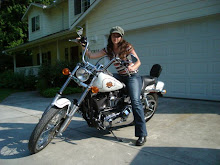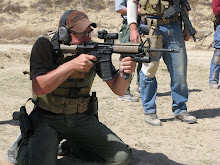Class: Instructor Development
Lead Instructor: Marty Hayes, Firearms Academy of Seattle; Director
Assistant Instructor: Nick Bolton, Firearms Academy of Seattle; Senior Staff Instructor
I'll start by saying it's good to be home! A week away is about all this old home body (not to be mistaken for home boy) has in him any more. For those of you who missed hearing where I disappeared to after the PM meeting at Oly II I was attending the week long Instructor Development class at the Firearms Academy Seattle. The purpose of the class we defined in our first class room session by breaking down the problems our students face. For civilian or law enforcement the problems really are no different the only disparity is the rules of engagement. The civilian is obligated to flee a gun battle when ever possible and the LEO is duty bound to prevent the criminal ( and lets face it if you shoot someone other than a current or about to be criminal there are serious problems in the way you live your life civilian or LEO). We as a class found the problem to be two fold further described as proactive and reactive. An alarm call for the LEO is proactive. They must search that building to find the cause of that alarm, similar for the civ. who has a choice to remain barricaded (reactive) and wait for help or if they have children etc. who are not in their direct control to gather them which would then transition the problem to being proactive. An LEO being attacked at a traffic stop is strictly reactive like the civ. caught in an armed robbery. We examined the problems in detail and then defined the skills necessary to solve them. For instance a 1.4 second draw stroke and the ability to get well centered hits while rapidly moving off the line of attack is a very useful skill for the LEO who expects to get license and registration and instead is faced with a meth heads stolen revolver. Likewise the civ. who finds themselves face to face with an offender willing to carve their heart out just to prevent an ID after a car jacking. Let's face it people you don't gun fight to save your car so you are most likely not going to being ahead of the curve. Your going to quietly hand over your keys and start to leave. So when he/ she suddenly realises you know what they look like and grabs that big, ugly knife and says "now you gonna get cut foo" your going to need to turn up the afterburners. 1.4 secs. is going to feel like a decade in that situation. How about the unlucky LEO who is on scene when an active shooter situation breaks out. Picture a crowded mall or school hallway with a madman and a gun. Yes training doctrine probably says to wait for the cavalry. They don't have SWAT just because they look good in black, however not many people LEO or otherwise could stand by and wait. Looking at the problem what skills might the responder need? How about the ability to make precision hits to the cranial ocular cavity (eye box) to sever the body, brain connection and shut down the threat? In these situations a miss is unacceptable as the result will most assuredly be the loss of innocent lives. So these shots might have to be taken from outside the standard 21 feet that most gunfights occur in. Hostage situation? Same concerns. What else do we know about gunfights? They occur in low light involve multiple assailants and everybody will be on the move. Skills needed to deal with this? Shooting while moving, engaging multiple threats, engaging moving threats, and doing it all at times with out the benefit of seeing your sights and at times with out seeing your weapon at at all.
Having spent the time to examine the problem we moved to the range to first ascertain that we had the skills to deal with these problems and then to see how we had learned them so we could teach them to those in need.
First we examined the foundations of combat marksmanship;
1) A good strong fighting stance (think fist fight then insert gun)
2) A solid real world grip on the gun (not a puny bulls eye grip folks)
3) A clear precise sight picture
4) A smooth steady trigger pull with good follow through
This was inculcated by the use of one shot drills intended to produce very tight groups at distances out to 25 yds. To teach these skills we learned about default stance, blending the Weaver and the Isosceles stances and the thumbs forward or thumbs locked down grips to match the gun to the shooter in such a way that even without sights the results would be acceptable within the recognized gun fight parameters.
Next we focused on the draw stroke which needed to be smooth, have very economical motion and put the gun into a firing position as quickly as possible.
People run out of bullets in gunfights. Fact. They get a huge adrenalin dump, they squeeze the trigger until the it quits going BANG and they don't know what to do. We learned to reload a gun. FAST. A thorough examination of the techniques necessary to change magazines in our auto pistols or to purge empty brass and stoke a double action revolver ensued until we all learned the pitfalls of these skills and how to correct them in the student.
A trip to the dark house followed to verify what we learned about the "default stance".
Backing up briefly, the "Default stance" came from the saying that "under extreme stress you will not rise to the occasion but rather default to your training." To understand this we watched a video of a shooter in competition who had just had three days training in the use of the strict Weaver stance. At the end of the three days she entered a man on man (you get the point) shoot off and under the stress of competition went right back to the near Isosceles stance she had used previously.
This lesson being fresh in our minds we tested the default stance we had worked out in daylight in the dark. Very educational. For some there was a lot of work to be done to the "default stance" once the lights went out, for others it was very gratifying to find that our accuracy was not hindered when we could only vaguely see the targets and couldn't see our sights at all.
To me this is the essential skill of the combat marksman. Quickly put the weapon in play and with a hard focus on the threats engage successfully without the use of sighted fire. Prefacing all that with the disclaimer that we should rely on this primarily inside the 21 feet in which most gunfights occur.
For the core of the class we dealt with these basic skills using ourselves as students diagnosing and fixing problems in our own execution with tips and techniques handed down from Marty and Nick when we got stuck. We turned in to new shooters or less experienced shooters by learning all the skills with our revolvers, by learning them left handed and by learning them with different guns.
Finally on the last day we had a chance to validate our own skills under pressure with a man on man competition. With a blast of gunfire and the lovely sound of ringing steel a double elimination tournament kicked off. Round after round the matrix progressed until one shooter took possession of the coveted Silver Bullet Trophy! What's this in my pocket?! Why it's a SILVER BULLET! Yes folks that's right and I will say that this one I'm proud of. Only myself and one other individual in the class had not garnered the Master rating as hand gunners so I feel like I received some validation of my skills against such a diverse and capable group of shooters.
The end game was a quick rendition of the Masters test which ended up being a diagnostic for me to show which skills yet lacked. I missed my Master rating this time by only the slightest margin through deficiencies in the execution of my strong hand only stance, by being less then perfect in my high speed default stance. The opportunity was given to clean up these tests and garner the rating but I feel at this time like I want to work on those skills so I own the test not just pass it.
In summation,
Marty Hayes is one of the greatest instructors I have ever met. His passion and skill are evident and the honest look he is willing to take at both FAS doctrine and outside ideas is unmatched in this industry of balloon heads.
Nick Bolton is a superb English gentleman and his effort to bestow every shred of knowledge he can conjure on his students is absolute.
No opportunity to train with these artisans of the trade should be missed.
To my friends who shared the firing line this week should any of you happen across this page, I wish you all the best in your personal endeavours, be safe, be vigilant, and don't forget to take the tape off your guns!!
Subscribe to:
Post Comments (Atom)








No comments:
Post a Comment